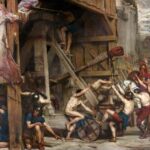Hadrian’s Wall, Vallum Hadriani, is perhaps the most famous of the Roman limes. It was built in the years 121-129 CE and stretched 117 kilometres in the present-day village of Bowness on the Solway Firth to the Segedunum fortress (today it is Wallsend on Tyne).
So the embankment crossed Britain almost along a line from east to west and – probably – was supposed to defend this northernmost Roman province from Caledonian attacks Picts. Or, as the poet would say, he was to separate Light from Darkness. But you already know that. There is, however, something that you may not necessarily have heard of.
Wandering along the old fortifications – quite well preserved despite the passage of years – you can notice the extremely regular construction of the fortifications. Every 500 meters, watchtowers (now called “mile-locks”, “milecastle” in English) were built up, and every 1.5 km small camps were built for soldiers guarding the wall. Regularly – this is important information – there were also gates: Hadrian’s Wall was not supposed to separate the Caledonians from the Empire – it only had, as we would say today, regulate the flow of people and goods. So they were actually 117 kilometres long and quite expensive to build tolls.
Well, maybe I exaggerated a bit with these construction costs – it is worth remembering that the fortifications were built by soldiers from three local legions – and it was probably not the most pleasant service. From the documents preserved in Windoland (the northernmost Roman city, abandoned and uninhabited since the end of Antiquity, and thus so liked by archaeologists) – and it was the largest private correspondence of ordinary Romans – we learn that the climate of Britain at that time – a moderate maritime – was the cause of grumbling southerners. It was cold and humid, there were swamps and peat bogs around Vindolanda (the peat soil meant that many everyday objects survived there that would not normally have survived), and Vindolanda itself… Well, who saw the remains of the city, this one knows that it was not a great metropolis. In addition, in Britain, there was no way to grow a vine – and when it grew, the wine was extremely despicable. In addition – probably, I can confabulate a bit here, but after all, man is always a man – Britain was far from Rome. Which could mean that officials – for example, those who administered the construction of Hadrian’s Wall – felt extremely unpunished… Really, military service in Britain could not be among the favourites among Roman legionaries.
Maybe it is a kind of soldier-builder revolt that is the reason for the strangest construction of Hadrian’s Wall? This is because near the ancient Vindolanda and modern Housesteads there is a gate… to nowhere.
As I wrote – the rampart crosses Britain almost in a straight line, running like an arrow over the local hills, then falling, then rising, and the gates, towers and forts are at regular intervals. But what was the point of building a gate when the wall was placed on the edge of a cliff? I do not see it – so maybe it was such a manifestation of the builders’ rebellion: you tell us to build, we will build it as you tell us. This would probably be the first nomen omen Italian strike in history.
An alternative translation is probably just too strict adherence to orders and guidelines: if there is to be a gate at this kilometre of the wall, it must be – and no matter where it leads.
Which of these two possibilities is true (if any, of course) we will probably never know.
And one more thing: which gate is so unruly – because they all have their numbers? I will keep this information in pectoram – go and look for yourself, it is one of the attractions of Hadrian’s Wall.










